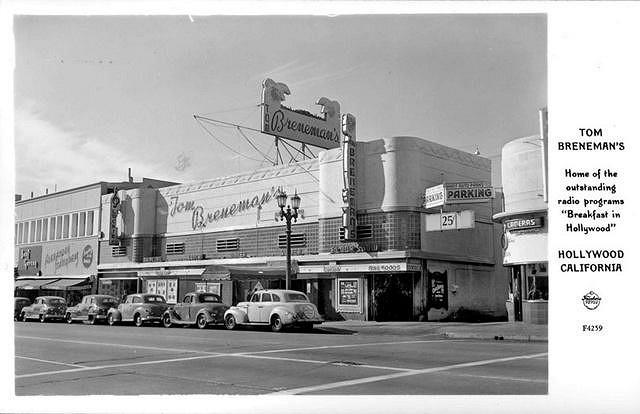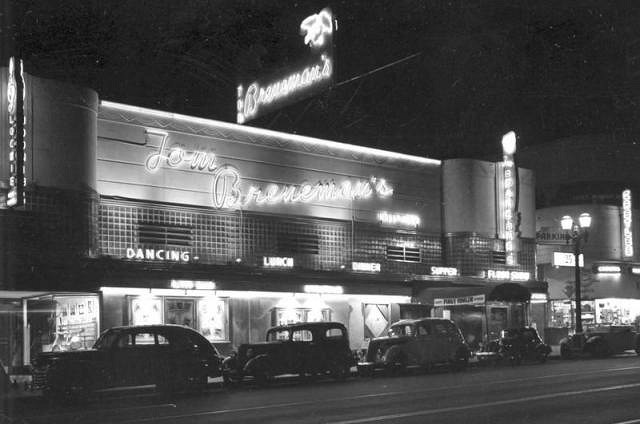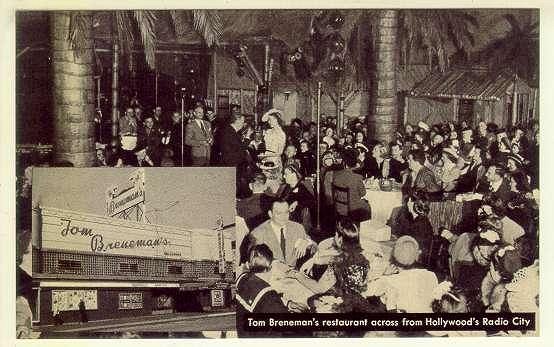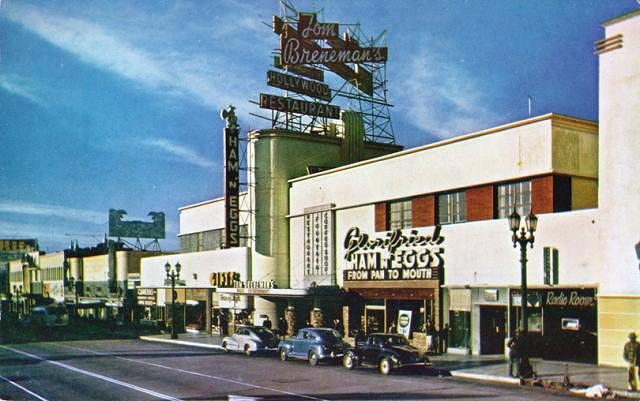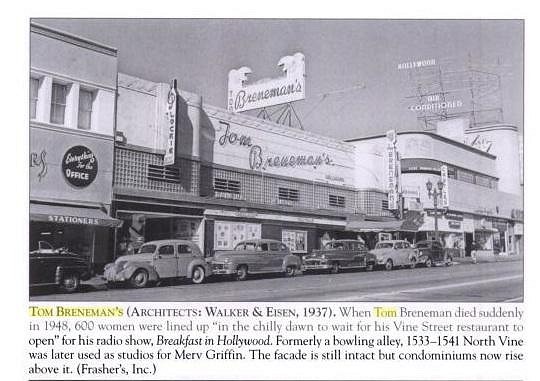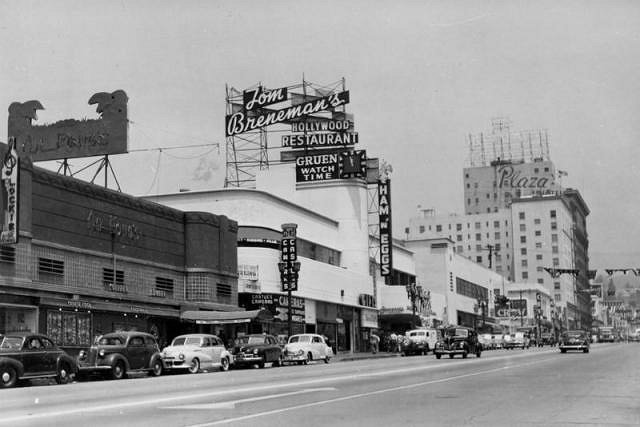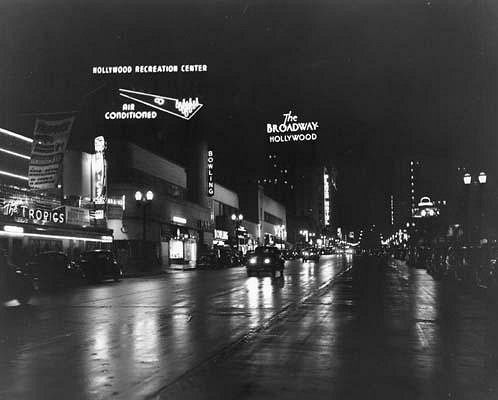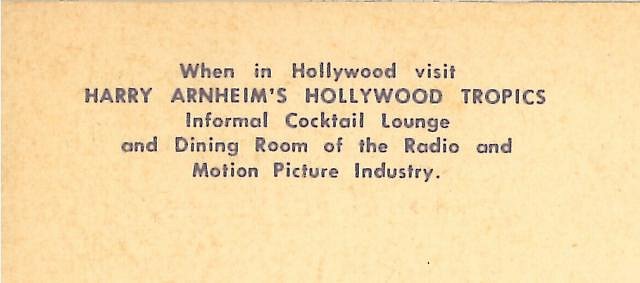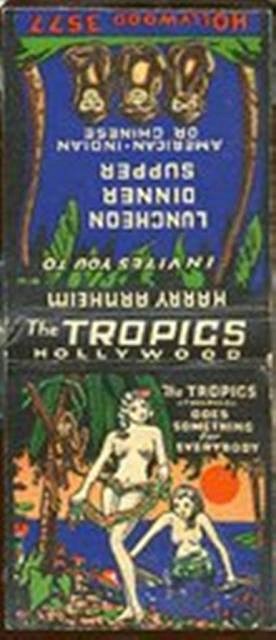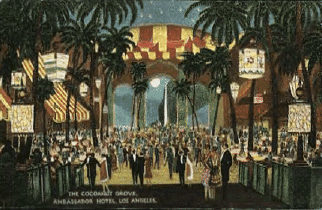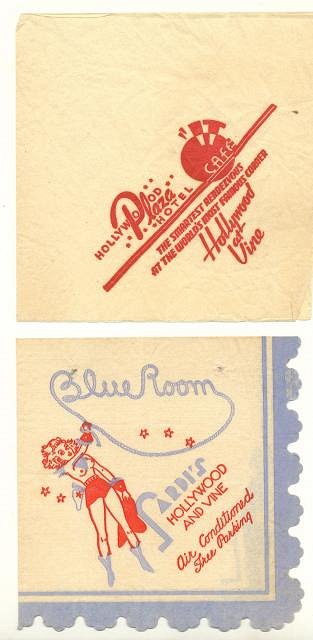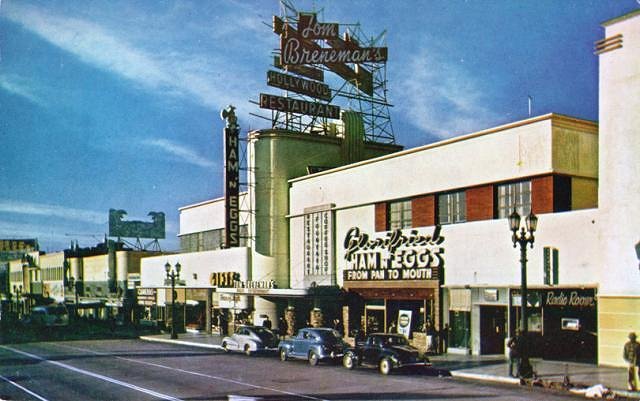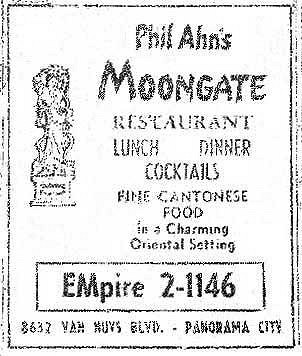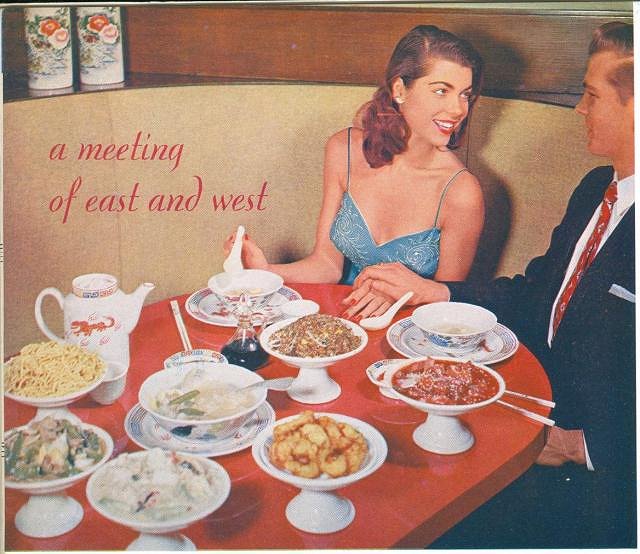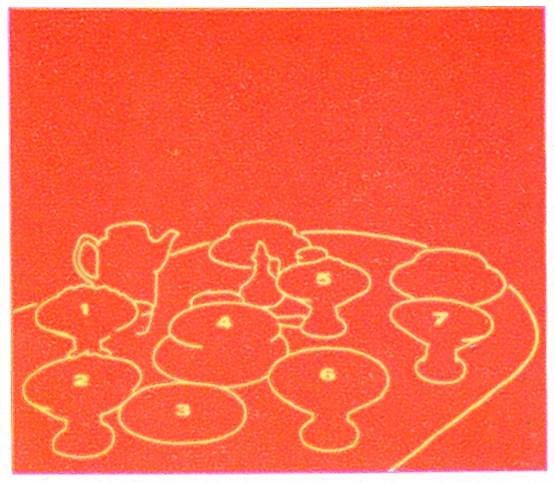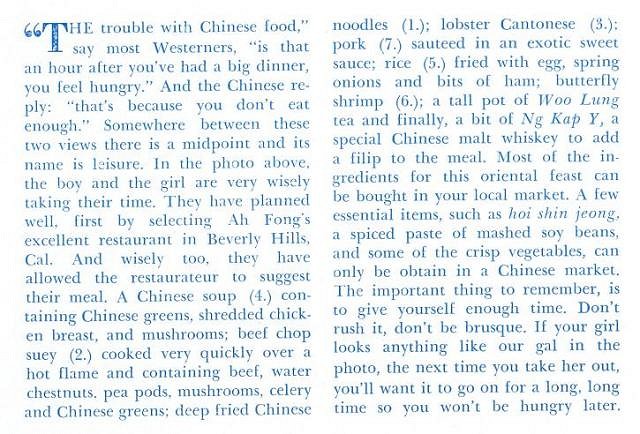Tiki Central / Locating Tiki
Tom Breneman's/Ah Fong's
Pages: 1 24 replies
|
TS
Tiki Shaker
Posted
posted
on
Tue, Dec 30, 2008 4:28 PM
Ok.. I kind of went on a little internet adventure today. It all started with me coming across this postcard.
When I saw it, I thought the sign looked like it had a couple of palm trees. So I did some research. I found this info on wikipedia "Breakfast in Hollywood was a popular morning radio show created and hosted by Tom Breneman who broadcast from 1941 to 1948 on three different radio networks: NBC, ABC and Mutual. These unscripted shows were spontaneous and involved much audience participation. Breneman's many guests included such stars as Jimmy Durante, Andy Devine and Orson Welles. Then I came across two better pics of the outside.
I knew for sure that they were in fact palm trees. Then I found this awesome pic of the inside.
Obviously polynesian. So then I began to wonder, is this the first place he started at or is this the place he moved to and opened up his own place? I figured this was his second place, especially when I came across this.
In the background, you can see the place he ended up moving too. I had to find out what the place was before he moved there. It obviously must have been polynesian. But then I came across this.
Bowling alley? There's no way that place was a bowling alley. Maybe his first place was a bowling alley and they got the caption screwed up? Finally, I found this pic.
The title of this one has (1948) in it. So who knows. But I did look up "Ah Fong's" and found this. "Benson Fong, Character Actor and Founder of Cafes, Dies By Penelope McMillan Benson Fong, a character actor and founder of the well-known Ah Fong's restaurants in the Los Angeles area, died Saturday. He is survived by his wife, Gloria, five children and three grandchildren. Memorial services will be held at 11 a.m. Wednesday at Forest Lawn Memorial-Park, Hollywood Hills. Fong was the son of a wealthy Sacramento merchant who went broke, became ill and died during the Depression of the 1930s. Fong told interviewers that, originally, he had no thoughts of becoming either an actor or a restaurateur. In 1943, while having dinner with some friends in Sacramento, he was approached by a man from Paramount Pictures, who asked if he would like to be in a movie. Fong ended up with a role in a film called "China," starring Loretta Young and Alan Ladd. He was also offered a 10-week contract, for $250 a week. "It looked like a tremendous fortune and I accepted quickly, afraid they might think twice and back out," he told an interviewer. "I couldn't read lines too well, but World War II was under way and all the studios were looking for actors with Oriental features. I bicycled around from one set to another, playing a Japanese here, a Filipino there, a Chinese on still other days." The next year, he played one of the sons in "Charlie Chan in the Secret Service." Other films in which he appeared included "Thirty Seconds Over Tokyo" (1944); "Keys of the Kingdom" (1944); "His Majesty O'Keefe" (1954); "The Flower Drum Song" (1961); "Our Man Flint" (1965) and "The Strongest Man in the World" (1976). His chain of five restaurants, which he built up over a 30-year period, resulted from a casual remark made by actor Gregory Peck. After appearing together in "Keys of the Kingdom," Fong later recalled, Peck suggested they start a restaurant together. "The idea appealed to me," Fong said. By that time, he had met his future wife, Gloria, who was working as an actress. "We wanted to get married. But I wanted to have a predictable income, instead of becoming one more struggling actor. I decided it (the restaurant) would have to be done with my own capital, so I began saving." Two years later he had $11,000 and, in 1946, opened his first Ah Fong's on Hollywood's Vine Street. By 1971, four others had opened - on Sunset Boulevard in Hollywood, in Beverly Hills, Encino and Anaheim. The Ah in the Ah Fong's name is a term of respect in Chinese, he said. But actually, he said, he thought up the name while looking at the wrapper of an "Oh Henry!" candy bar. Fong retired from the restaurant business two years ago. At the time of his death, only the Hollywood Ah Fong's remained, owned by a relative. An avid golfer and frequent traveler to the Orient, Fong practiced meditation and once described himself as "a split personality - half a pound Oriental and eight ounces Yankee." In one interview, he said he wanted to "sum up" his life this way: "Whatever I am, spiritually speaking, is what I've wanted to be, nothing more and nothing less. Call me a happy man and you call me by my rightful name." I also found this quote from an interview with Beachbum Berry conducted by Robert Simonson. Q: How did you develop an interest in tiki drinks? A: I grew up in the San Fernando Valley in the late '60s and there were a ton of these places. My parents liked Chinese food so they would go to this place, Ah Fong. It had opened in the early '60s as the Bora Bora Room, but whoever opened it spent so much money on decor that they went broke soon after they opened. There was this guy named Benson Fong, who was a Chinese restaurant magnate back then; he would move his Cantonese crew into Polynesian places if they couldn't recoup their costs, and rename them Ah Fong. Then I also found this awesome little clip. And finally, after all of that, I decided too look up Fong's on TC and it brought me back to this awesome thread. http://www.tikicentral.com/viewtopic.php?topic=29260&forum=1 And in it, Bora Boris posted this photo.
It looks like the bigger sign was where the bowling alley was at. And perhaps before he or Fong's went into there, it was something called the tropics? I don't know, after all of this my mind is pretty boggled. update Ok... I just found this on some Hollywood and Vine history site. Here's the paragraph. "By 1945, Hollywood & Vine was the star-studded center of show business. Celebrities danced the night away at the Brown Derby, Clara Bow’s “It” Café, and Al Levy’s Tavern. They met their fans for breakfast at Tom Breneman’s restaurant, Tropics Café, from which live interviews were broadcast on national radio. Art Linkletter’s television show, People are Funny, used the corner to interview the ‘man on the street’, while Ralph Edwards and his television show, Truth or Consequences, filmed stunts along the boulevard. When World War II ended there were celebrations all over Hollywood, but it was the corner of Hollywood & Vine where the celebrations made history by shutting down the streets." [ Edited by: Tiki Shaker 2008-12-30 17:06 ] [ Edited by: Tiki Shaker 2008-12-30 17:07 ] |
|
B
bigbrotiki
Posted
posted
on
Wed, Dec 31, 2008 12:45 PM
Nice research into this Pre-Tiki place. I knew of the name, but I had no idea it was decorated so tropical. The timeline is quite confusing, the changes of location and ownership seem to have happened in close time proximity. |
|
TS
Tiki Shaker
Posted
posted
on
Wed, Dec 31, 2008 12:58 PM
I know... it's really hard to tell what came first and in what order. I do like the interior though, it reminds me of the pictures I have seen of the Cocoanut Grove. |
|
T
TabooDan
Posted
posted
on
Wed, Dec 31, 2008 1:50 PM
Cool post TikiRacer! It's pretty amazing what one little thing you see or hear will make you look into. |
|
H
hiltiki
Posted
posted
on
Wed, Dec 31, 2008 2:50 PM
My other half had this to offer. |
|
A
arriano
Posted
posted
on
Wed, Dec 31, 2008 4:32 PM
Wow, this is some pretty impressive research. I've always wondered what was so special about "Hollywood & Vine." You go there now and it doesn't seem to be that big of a deal. But in the 1940s with radio being such a big deal, that certainly would have made it famous -- especially if radio announcers said, "Coming to you from Hollywood and Vine...." |
|
D
Dustycajun
Posted
posted
on
Tue, Jan 6, 2009 6:49 PM
I don't think that The Tropics shown in the photo posted by Bora Boris was part of Tom Breneman’s restaurants. I'm pretty sure that was Harry Arnheim's Hollywood Tropics located on Vine Street at Sunset. Here is a postcard I have of the interior. Some very early pre-tiki vibe going on in there.
An a matchbook I found on-line.
DC |
|
TM
Tipsy McStagger
Posted
posted
on
Tue, Jan 6, 2009 9:20 PM
.....korla pandit was a regular performer there.....now that's just plain cool. |
|
C
congawa
Posted
posted
on
Wed, Jan 7, 2009 11:14 AM
A few additional notes I can add on this: Yes, this became Merv Griffin's TAV Theater, where they taped his show and a lot of his big game shows (Jeopardy, Wheel of Fortune). It's still there, but has partly been converted into a mall and condos (though part of the streamline moderne look is still there). Tom Breneman's Breakfast Club grew out of a Los Angeles businessmen's group called the Breakfast Club, and they greeted each other with the phrase "Hello Ham! Hello Eggs!" The building down from Breneman's at the corner of Sunset & Vine became the famous Wallich's Music City big record (Glen Wallich's was one of the founders of Capitol Records. It was torn down in the late 70's and replaced with a mini-mall (which had a Fatburger and a Golden Bird I used to eat at) which has since been torn down and replaced with a Borders that looks more like the original building. The indoor palm trees look of the interior was a direct ripoff from the famous Cocoanut Grove nightclub (recently razed along with with its parent Ambassador hotel), which had the palm trees with monkeys in them. The Cocoanut Grove was the big celebrity hangout of the early 1930's, when Bing Crosby became famous as the singer of the Gus Arnheim Orchestra there. And I'm pretty sure Harry Arnheim (of Hollywood Tropics) was Gus' brother, so there's another Cocoanut Grove connection. Benson Fong took over as Charlie Chan's number one son in the later mid-1940's Charlie Chan films for Monogram (the ones that have Mantan Moreland as chauffeur Birmingham Brown). Benson played the jive talking son who was confounding his father with hipster lingo and argot that Chan Sr. couldn't understand. While we're on the subject, there was another Asian-American film actor from that same period who had a restaurant: Philip Ahn, who was Korean but frequently played Japanese-American spies and soldiers in World War II era movies (when of course genuine Japanese-American actors were locked up in internment camps). His place was the Moongate Restaurant in Panorama City (north San Fernando Valley) which had a cool industrial mid-century modern look:
|
|
C
congawa
Posted
posted
on
Wed, Jan 7, 2009 11:23 AM
I should add that that shot of Phil Ahn's Moongate came from somebody's flickr site who took a shot of it today. It's virtually otherwise unrecognizable, with ugly mix-styled buildings built around it, yet somehow they retained the "porthole"! http://www.flickr.com/photos/dogwelder/466748790/in/photostream/ |
|
T
tikiyaki
Posted
posted
on
Wed, Jan 7, 2009 11:50 AM
Gadzooks !!! That's hideous (the new transformed one I'm talking about) Then again, so is Panorama City. :o |
|
D
dogwelder
Posted
posted
on
Sat, Jan 10, 2009 6:35 PM
I'm glad to see other people interested in older Los Angeles! I took this picture as part of an ongoing project comparing old Los Angeles to its current state. I found the original picture in the Los Angeles Public Library's digital archive. I can't link to it directly, but if you go to the main page (http://lapl.org) there's a link to the archive. Other great image searching sites for Los Angeles in particular and California in general are the digital archives for USC and UCLA, as well as the California State Library archive. Oh, and my project is here: http://www.flickr.com/photos/dogwelder/sets/72157594197422246/ |
|
H
hiltiki
Posted
posted
on
Sat, Jan 10, 2009 8:14 PM
The neighborhood that was Vine Street, between Hollywood Boulevard and Sunset Boulevard, was a concentration of night spots. Clara Bow's It Cafe, north of Tom Breneman's, was next to Mike Lyman's restaurant. Phil Selznick was proprietor of the It Cafe after Clara Bow moved on. Phil later opened Phil Selznick's Blue Evening in Toluca Lake in the 1950's. By the early 1960's, the It Cafe reopened as The Westerner, operated by the late Carl Ferraro of Dresden Room fame. The Blood and Sand cocktail, which was the signature drink at the Dresden in the 1940's, was served by bartender, James Rousch and others. Before Carl took over the Dresden in 1954, he operated the lobby restaurant at the Lido Hotel in Hollywood. Besides Tom Breneman's Breakfast in Hollywood on Vine, the program at one time aired from Sardi's, on Hollywood Boulevard, near Vine. Vine Street also was host to The Firefly, the Office, The Spotlight, the Conga Room, the Tropics and many more clubs through the years. (See photos of cocktail napkins from the It Cafe and Sardi's and a photograph of the razing of Tom Breneman's)
|
|
B
bigbrotiki
Posted
posted
on
Sun, Jan 11, 2009 7:56 AM
I had to pull that one down from the top, I just can't refuse the opportunity for a direct Before and After juxtaposition. |
|
C
congawa
Posted
posted
on
Mon, Jan 12, 2009 11:05 AM
Thanks for the great Flickr site...I love "then and now" photos (even when the "now" is a bit downbeat). |
|
A
arriano
Posted
posted
on
Mon, Jan 12, 2009 1:21 PM
My usual complaint with "before and after" photos is that the new photos aren't taken from the exact same spot and the result are bad, unhelpful comparisons. But you have done a very, very good job. I think you should put out your own before-and-after book, because you blow away the competition that I've seen. |
|
BB
Bora Boris
Posted
posted
on
Mon, Jan 12, 2009 7:00 PM
Congawa thank you for finding that picture in Dogwelder's Flickr account and Dogwelder thank you for finding it in the LA Public Library archives. I know that the photo archive can cause headaches on occasion. Phil Ahn's Moongate is on a list of places I've found in old L.A. phone books that I've been meaning to check out. Here is an ad from 1959. It looks as if the statue in the "Porthole" is their logo. The "Porthole" is actually the Moongate.
I'd still like to see the inside even though it's been 50 years! So maybe I'll stop by the La Sierra Nightclub and see although the reviews I've read say to stay away and it looks like their doing a new Grand Opening this month so if there were any remnants of the "Charming Oriental Setting" left it's probably toast. I also agree with Arriano that your pictures are great Dogwelder and that other examples of before and after photos most notably the Then and Now series from Thunder Bay Press are awful to the point where you think “Did you even slow your car down to take this picture?” :) However Pete Moruzzi’s Havana Before Castro is an excellent example of before and after photography, Pete nails it. |
|
B
bigbrotiki
Posted
posted
on
Mon, Jan 12, 2009 7:16 PM
Oh? And how about the photographer? :D Sigh, that Moon Gate building so much reminds me of Madame Wu's and her Santa Monica Chinese Modern temple, and the many Tony Ramos-mixed Fogcutters I savored in the bar, in the company of the Bum, and Kev'n'Jo, and the rest... |
|
BB
Bora Boris
Posted
posted
on
Mon, Jan 12, 2009 7:33 PM
eh... he's just okay. :lol: |
|
H
hiltiki
Posted
posted
on
Mon, Jan 12, 2009 7:57 PM
On that note does anyone know where Tony Ramos is now days? |
|
B
bigbrotiki
Posted
posted
on
Tue, Jan 13, 2009 8:57 AM
Last time I asked Jeff he told me Tony had retired from mixology duty. |
|
O
Otto
Posted
posted
on
Mon, Jul 4, 2011 10:49 PM
Back to the topic of Ah Fong's, since this seems to be the only thread for it, I noticed this cool photo from the owners' son here
|
|
C
congawa
Posted
posted
on
Tue, Jul 5, 2011 10:37 AM
I just recently finished reading the book Orange Sunshine by Nick Schou, about the Laguna Beach hippie group Brotherhood of Eternal Love--who were associated with Timothy Leary and were responsible for a lot of LSD distribution and hashish smuggling of the late 60s and early 70's (and the movie Rainbow Bridge). Oden Fong is mentioned a few times as he was associated with the group (he later got religion and is now a pastor at Calvary Chapel in Costa Mesa): http://www.finalfrontier.org.uk/index.php?main=13&sub=2&page=30 Since I grew up in South Orange county, I remember driving past the Laguna Beach hippies who would congregate outside Taco Bell (sometimes on our way from family brunch at the Outrigger or dining at Royal Hawaiian) so even though I was too young to know the real details, the above mentioned book answered a lot of questions. Caltiki Brent |
|
T
tikilongbeach
Posted
posted
on
Thu, Nov 14, 2013 8:28 AM
I found this 1972 menu from Ah Fong's on pinterest.
|
|
M
martian-tiki
Posted
posted
on
Tue, Oct 6, 2015 8:50 PM
Article on Ah Fong's from (some cartoons from this issue will also be appearing shortly in the Desert Island cartoons thread)
|
Pages: 1 24 replies

